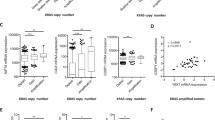Abstract
Breast cancer is the most prevalent malignant disease in women. Amongst other risk factors such as age, life style, genetic factors and hormone status, exposure to ionizing irradiation is a known risk factor. Markers of radiation-associated breast cancer have been now identified at the DNA-, miRNA- and protein levels providing the starting point for the identification and personalized treatment of secondary, radiation-induced breast cancer.
Similar content being viewed by others
Literatur
Hanahan D, Weinberg RA (2011) Hallmarks of cancer: the next generation. Cell 144:646–674
Hastings PJ, Lupski JR, Rosenberg SM et al. (2009) Mechanisms of change in gene copy number. Nat Rev Genet 10:551–564
Kneissig M, Bernhard S, Storchova Z (2019) Modelling chromosome structural and copy number changes to understand cancer genomes. Curr Opin Genet Dev 54:25–32
Hess J, Thomas G, Braselmann H et al. (2011) Gain of chromosome band 7q11 in papillary thyroid carcinomas of young patients is associated with exposure to low-dose irradiation. Proc Natl Acad Sci USA 108:9595–9600
Byler S, Goldgar S, Heerboth S et al. (2014) Genetic and epigenetic aspects of breast cancer progression and therapy. Anticancer Res 34:1071–1077
Wilke CM, Braselmann H, Hess J et al. (2018) A genomic copy number signature predicts radiation exposure in post-Chernobyl breast cancer. Int J Cancer 143:1505–1515
Wilke CM, Hess J, Klymenko SV et al. (2018) Expression of miRNA26b-5p and its target TRPS1 is associated with radiation exposure in post-Chernobyl breast cancer. Int J Cancer 142:573–583
Author information
Authors and Affiliations
Corresponding author
Additional information
Horst Zitzelsberger 1982–1988 Biologie- und Chemiestudium an der TU München. 1993 Promotion und 2002 Habilitation (Strahlenbiologie) an der LMU München. 2001–2009 AG-Leiter am Institut für Molekulare Strahlenbiologie, Helmholtz Zentrum München. Seit 2008 Apl. Professor an der LMU München (Medizinische Fakultät). Seit 2010 Leiter der selbstständigen Abteilung Strahlenzytogenetik am Helmholtz Zentrum München.
Kristian Unger 1998–2006 Biologiestudium (Diplom) an der Universität Erlangen und LMU München. 2007 Promotion an der LMU München. 2007–2011 Postdoc am Imperial College London, UK. Seit 2011 Leiter der Arbeitsgruppe Integrative Biologie in der Abteilung für Strahlenzytogenetik am Helmholtz Zentrum München.
Rights and permissions
About this article
Cite this article
Unger, K., Zitzelsberger, H. Molekulare Muster von strahlungsbedingtem Brustkrebs. Biospektrum 25, 617–619 (2019). https://doi.org/10.1007/s12268-019-0210-3
Published:
Issue Date:
DOI: https://doi.org/10.1007/s12268-019-0210-3




